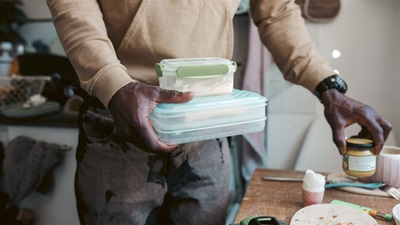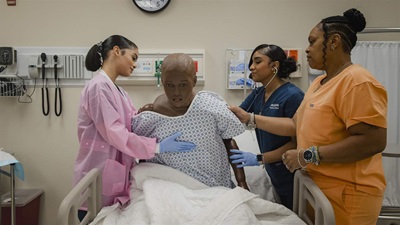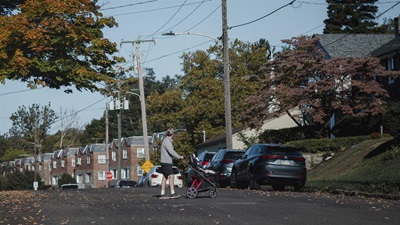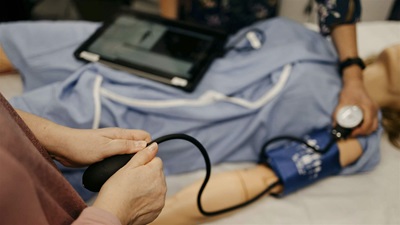How Philadelphia Can Reduce Barriers to Opioid Use Disorder
Experts discuss patient-centered approaches to improve access and quality of care

The opioid overdose crisis continues to have a big impact in Philadelphia, which has one of the highest rates of overdose deaths in the country. A recent poll of Philadelphians by The Pew Charitable Trusts shows that 44% know someone who has or has had opioid use disorder (OUD), and 1 in 3 know someone who has died from an overdose. Access to high-quality, evidence-based treatment remains a challenge for many who seek it.
On June 24, Pew and the University of Pennsylvania’s Leonard Davis Institute of Health Economics hosted a program entitled “Improving Low-Barrier Access to Opioid Use Disorder Treatment in Philadelphia.” This in-person session brought together policymakers, public health researchers, and treatment providers to share research and on-the-ground experiences about the practical barriers that people face in accessing buprenorphine, one of three FDA-approved medications for OUD, and, critically, remaining in care after they start treatment.
Dr. Maggie Lowenstein, addiction medicine physician and an assistant professor at the Perelman School of Medicine, started the event with a presentation of recent Pew-funded research that used a secret shopper methodology to highlight variations in access to care for OUD in Philadelphia. The research team had reached out directly to local providers to simulate the real-world experience of someone seeking care for themselves or a client. Analyzing that work, Lowenstein identified “programmatic rules and requirements that get in the way and make it so hard for people to get help.”
The barriers include practices not based on current evidence, such as requiring counseling in order to receive buprenorphine medication, not providing buprenorphine prescriptions at the first visit, and requiring abstinence from opioids during treatment. The research findings point to the importance of implementing practices, backed by evidence, that provide rapid access to medication for OUD and flexible treatment models based on patient-centered goals. And these policies need to be clearly communicated to those seeking care.
“There are a lot of opportunities to overcome patient hurdles that we can expect and anticipate. Part of addiction is managing chaotic life circumstances,” Lowenstein said. “How can clinicians provide navigation and support to provide more flexible models for the patients who need to access them?”
Alex Duncan, project director of Pew's substance use prevention and treatment initiative, then moderated a panel to discuss ways to overcome these barriers. Dr. Sam Stern, medical director of addiction medicine and associate professor of clinical medicine at the Lewis Katz School of Medicine at Temple University, echoed Lowenstein’s concerns.
“There are challenges seeking care in traditional health care spaces,” Stern said. “Whether we call it ‘low-barrier’ or something else, we need to offer care to patients where they are and where they need it.”
Throughout Philadelphia, experts are working to introduce new strategies to reduce barriers and stigmas that get in the way of treatment. For example, Nicole O’Donnell, a certified recovery specialist at the Center for Addiction Medicine and Policy at the University of Pennsylvania Health System, described the hospital system’s “ warmline,” which attempts to connect people to OUD care. The telephone help line is available seven days a week and can help individuals get rapid access to support and resources, including same-day buprenorphine prescriptions, with or without insurance.
O’Donnell said that the health system launched the service in 2021 in response to the COVID-19 pandemic and that it still helps to fill gaps in access to care. For instance, “the warmline gets a lot of calls when individuals leave residential treatment and are not set up with a continuing care plan or bridge medication.”
When asked how barriers show up in their day-to-day experiences, panelists agreed that how people are perceived when seeking treatment continues to be an obstacle. “Stigma prevents people from getting treatment and services,” said Kelly Primus, deputy secretary of the Pennsylvania Department of Drug and Alcohol Programs.
Stern agreed. “Whether [it’s] the front desk, the nurses, or the doctors, how we talk to and about patients, they internalize it. The ways patients are treated impact their ability to stay in care and their desire to come back.”
When looking at the issue facing those with OUD, O’Donnell said that “stigma is always on the top of the list, and there’s a lot of patient-blaming. Doctors don't withhold medication for missing other types of appointments, but they do for [OUD].”
O’Donnell had participated in a previous Pew panel in 2022 that centered around stigma in the health care system relating to OUD.
Stern spoke of how outdated and unclear guidelines pose significant challenges to patient care. With the ever-evolving drug supply, including the introduction recently of medetomidine, a dangerous adulterant now commonly found in combination with fentanyl, medications aren’t as effective, and withdrawal can be more dangerous.
“Guidelines are always behind, and you can’t just admit patients to any hospital for detox. ... Long-acting injectable medications have been successful [in addressing the newer drug supply], but it’s a challenge getting it covered by insurance,” Stern said. “Part of the conversation should be around getting patients into [treatment] programs regardless of where they live or their insurance status.”
Panelists also referred to practical barriers that can prevent people from engaging in care, such as difficulties meeting their other basic needs. “Some individuals can get ‘stuck in residential treatment cycle’ because they have nowhere else to go,” said Marta Warner, clinical director of adult services for Philadelphia Community Behavioral Health. “Homelessness and other housing challenges keep people coming back to residential treatment [when outpatient treatment may be appropriate for some patients].”
Primus, reflecting on this issue from her state-level vantage point and years of experience in human services, agreed. “I have seen housing first in action, and I can tell you it works,” she said. “People who have lived in a state institution or hospital for years, if you can wrap the right supports around them, it works.”
The session provided an opportunity for collaboration and conversation across direct service providers, policymakers, and researchers on some of the challenges that patients face when they are entering treatment. Together, the speakers and participants engaged in meaningful and action-oriented discussion focused on identifying opportunities to make policy and practice improvements, with an emphasis on the importance of a holistic understanding of individual patient needs and the benefits of medical-provider flexibility and prioritization of patient choice.
Rishaun Hall works on The Pew Charitable Trusts' Philadelphia research and policy initiative.














